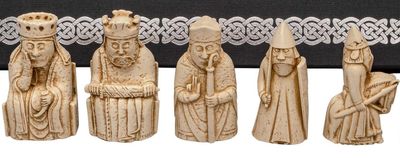Sessão iniciada como:
filler@godaddy.com
Sessão iniciada como:
filler@godaddy.com

There are eight kings in total, all seated on highly ornate thrones. Each grips a sword with both hands and rests it across his knees. Their cloaks are fastened above the right shoulder, leaving the right ann free to use the sword. The sword suggests conventional, physical strength, but also implies the administration of unswerving justice. The paternal characteristic of the kings is reinforced by the beards that most of them wear. Some of the beards are heavier than others, particularly BM 78, which is drawn with strongly incised lines.

All eight queens occupy thrones of similar construction to those of their kings. They wear veils underneath their crowns, a fashion of the late twelfth century represented, for example, in the Madonna and Child of the Lisbjerg altar in the National Museum of Denmark at Copenhagen, which dates to about 1150. The same headdress is worn by the female symbol of the Church used on the walrus-ivory cross of Grunhild in the same collection, dated to between 1150 and 1180.

Of the total sixteen bishops, seven are seated on thrones and nine are standing. They wear mitres, the ceremonial headdress of bishops, and they all carry a crozier, their hooked staff of office. Some of the standing bishops grip their croziers with both hands while others secure them with one hand, holding a Bible in the other or making a sign of blessing. They are dressed either in copes, which are fastened at the neck, or chasubles, which enclose the body entirely.

The fifteen knights sit astride sturdy ponies with shaggy manes which appear almost Icelandic in character. They all wear helmets and are armed for battle, carrying spears and shields, with swords slung around their shoulders. The knights provide a wealth of information about the arms and armour in use in the second half of the twelfth century. Their headgear includes the pointed, conical helmets with earflaps and nasal guards which were adopted from the eleventh century, and compare with those depicted on the Bayeux tapestry (c. 1066-82).

There are twelve warders, all of whom defend themselves with shields decorated in a similar fashion to the knights. They are represented as foot soldiers and each carries a sword. All wear helmets, apart from one who, along with three others, bites the top of his shield in the most disturbing manner.

The nineteen pawns all take very much the same, simple form. They are the only pieces not to be represented in human shape. Their origins in the history of chess might suggest that they would more properly be represented as foot soldiers, but this status is given to the rooks among the Lewis chesspieces.

(10,00 € envio)

Calling all Isle of Lewis chess fans. A fantastic opportunity to own the full scale replica Isle of Lewis pieces in a stunning presentation case, comprising:
◈ Imposing King (96mm)
◈ Thoughtful Queen (93mm)
◈ Stately Bishop (92mm)
◈ Fearsome Knight (89mm)
◈ Portly Warder (92mm)
The perfect gift to give away..... or keep for yourself
Please be aware, this item is NOT a chess set!
ATTENTION: This is NOT a chess set!
Full Scale Isle of Lewis Replica Pieces

by James Robinson (Author)
Buy at http://amazon.es
by David Caldwell (Author), Mark A. Hall (Author), Caroline M. Wilkinson (Author)
Buy at http://amazon.es
Posterity Legacy
Copyright © 2024 Posterity Legacy - Todos os direitos reservados.
Fornecido pela GoDaddy
Utilizamos cookies para analisar o tráfego do site Web e otimizar a sua experiência de utilização do mesmo. Ao aceitar a nossa utilização de cookies, os seus dados serão agregados com os de todos os outros utilizadores.